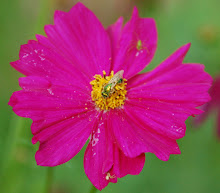I dug the bed according to the biointensive methods of John Jeavons, which I learned at a workshop put on by Green Corn Project, a local nonprofit that installs organic food gardens for families and individuals in need in central Texas, as well as schools and community centers. I also volunteered at one of their dig-ins, where they put in the beds in about four hours. (I've since become a board member of GCP, part of my amazing transformation from brown thumb to almost gardener.)
Double digging is the most labor intensive part of the biointensive method. It involves digging up the soil in trenches--the first dig--and then forking the same trench again, a slightly misnamed second dig. The goal is to dig down two feet, although this almost never happens with the first digging. And in Austin's soil, you'll often hit caliche long before that.
It took me (and my roped-in husband) a long, long day to double dig my bed, which is 4 ft x 12 1/2 ft. (Jeavons recommends beds that are 5 feet by 10 feet, but he also warns not to walk in the bed when you're done, so he either had freakishly long arms and could reach the middle of the bed without stepping in it, or I have short arms. If you are gardening with kids, I would highly recommend a bed no wider than four feet).
We pulled out pails and pails of rusty nails, broken glass and asbestos tile, and various other oddities. I did have a brief moment of hope when I found a coin. I thought the buried treasure would pay for the new garden, maybe a new house, . . . ah, the dreams I had, only to find out that the badly eroded the commemorative 1955 Eisenhower inaugural medal was worth three dollars, brand new.
Oh well, good thing I was saving money by growing my own organic veggies.
Here's how the bed looked a couple of months after I first planted it.

A slightly more close-up view: I was growing broccoli, cauliflower, buttercrunch lettuce, kale, swiss chard, mustard greens, and the compost crop.
 A close-up of the buttercrunch lettuce, which was quite prolific.
A close-up of the buttercrunch lettuce, which was quite prolific.
This fave bean was part of the compost crop in 2005--to help amend the soil--but I am growing some windsor beans (aka fava, or so says the seed packet) this year to eat. No beans yet but I remember they were slow growers.



No comments:
Post a Comment